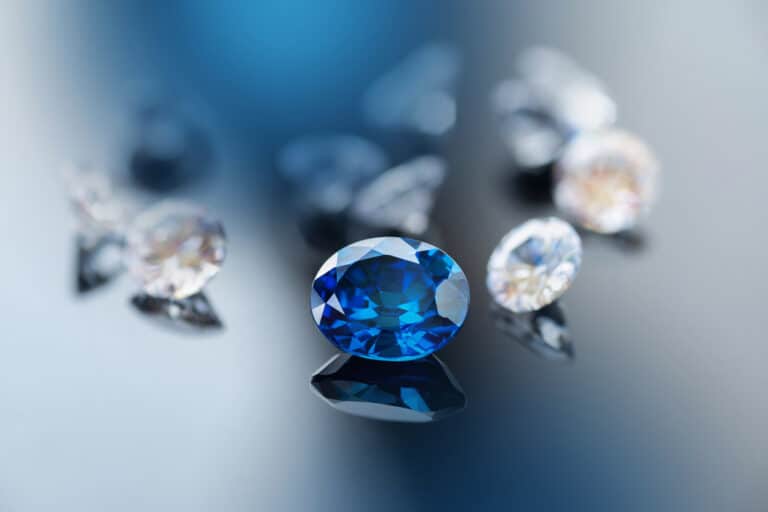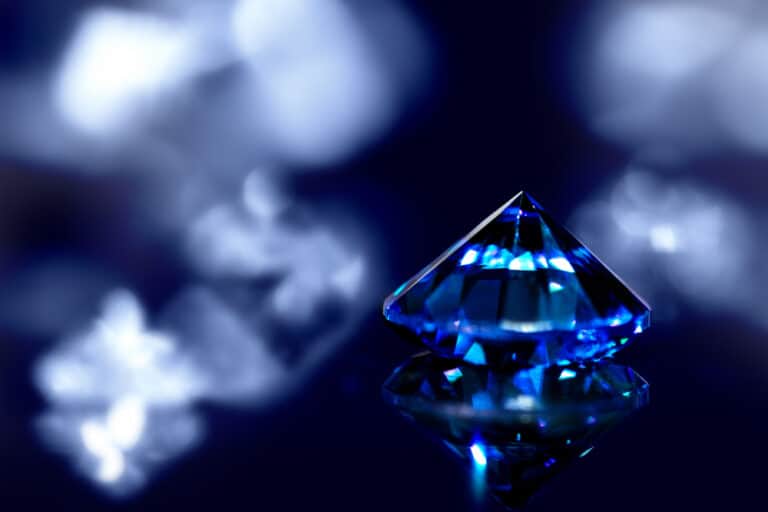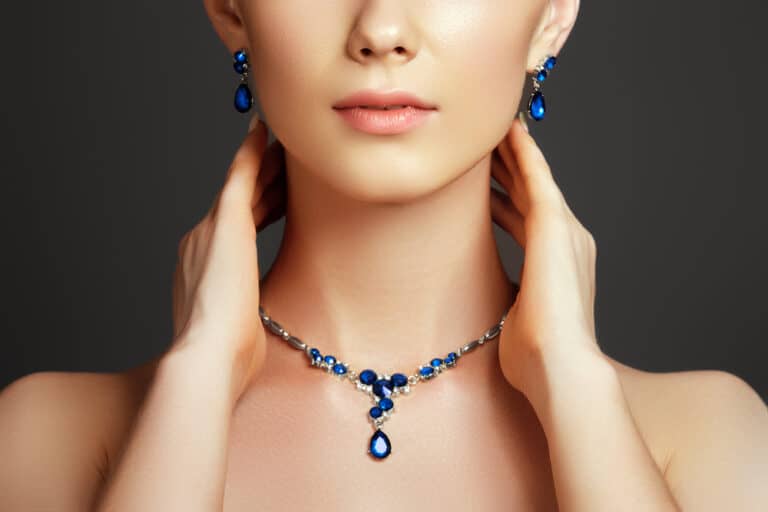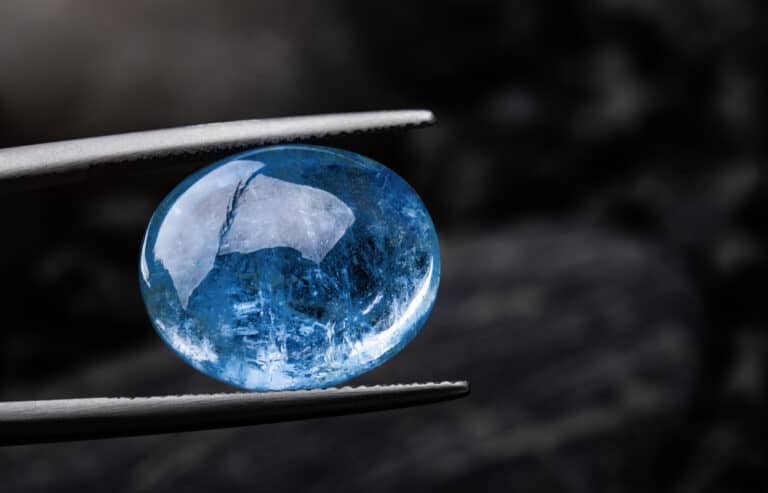Few can resist the sparkling allure of brilliant rainbow-hued sapphires, so it’s no wonder these much-coveted gems are in high demand! Although it’s only logical to wonder why some sapphires are darker and less attractive than other precious gemstones.
Some sapphires are darker than others due to the high concentration of trace elements like titanium and iron that saturates the sapphire’s hue. As a result, darker sapphires are less valuable than gems that are titanium free with intense velvety blue or violet hues with medium-dark colored tones.
Even though certain sapphires are darker than others, there’s much to discover about these fascinating gems and how they compare with lighter-hued sapphires. So, if you want to venture into the intriguing world of spectacular sapphires and discover what makes them so incredibly unique – read on!
Why Are Certain Sapphires Darker Than Others?
Before we delve into why sapphires may be darker than others, it’s essential to first understand their chemical makeup and how the colors are formed in their natural habitats.
Like rubies, Sapphires are classified as hardy corundum (aluminum oxide), with a typical crystalline formation developed by recurring anatomical patterns.
Corundum gems like sapphires are comprised of oxygen and aluminum. They are colorless and transparent in their purest form and are commonly referred to as white sapphires.
On the other hand – colored sapphires all contain trace elements that create their diverse rainbow hues in a wide range of stunning colors.
Iconic blue sapphire crystals all contain titanium mineral traces. Consequently, titanium plays a pivotal role in a corundum gem’s color saturation.
Therebefore, sapphires with higher concentrations of titanium are far darker than others. And the most prized sapphires are predominantly titanium-free.
However, sapphires also contain trace elements of iron which typically results in yellow and green sapphires. So, when iron and titanium minerals are blended, they produce blue sapphires.
High concentration levels of iron also increase a sapphire’s color intensity and result in yellow sapphires with an unappealing green hue that devalues the stone.
Certain sapphires also change color, like purple ones containing excessive traces of vanadium.
What Color Should A Sapphire Ideally Be?
Even though it is true that “beauty is in the eye of the beholder.” A sapphire’s color is determined by its hue (color) and saturation (purity or color intensity), including its tone, which refers to how light or dark the sapphire’s color appears.
The rarest and the most sought-after sapphire color is the sunset orange and pink-hued Padparadscha. Although, any “fancy colored” sapphire in shades of purple, pink, orange, yellow, or green is valuable. If its color is pure, vibrant, intense, and devoid of any grey or brown zones.
Valuable sapphires also tend to have fewer “extinctions,” which are grey or dark black zones. Conversely, extinctions are less visible in light-hued sapphires and far more prevalent in dark sapphires.
Are Dark Sapphires More Valuable?
The answer to that question is complex, as numerous factors make some sapphires more valuable than others.
Sapphires with an intense violet or velvety blue hue in medium-dark colored tones. They are highly coveted and far more valuable than sapphires that are either too light or have a dark greyish hue.
And according to the “Gemological Institute of America,” sapphires with high color saturation or purity are worth much more.
So, if you are considering investing in sapphires, opt for a gemstone that is not too light or too dark. Instead, aim for a stone with vibrant or bright color intensity and a medium-hued tone.
Mainly because the most coveted blue sapphires have mid-range-colored tones that sparkle when exposed to intense light.
How Does A Sapphire’s Color Determine Its Value?
Unlike diamonds with a sophisticated color-grading classification system, it’s far more challenging to assess a sapphire’s worth merely based on its color. Although, as previously mentioned, sapphires with intense or pure vivid colors fetch higher prices.
Blue sapphire hues consist of purple and violet, including secondary green tints. However, should a violet sapphire contain purple hues, it is worth far more than a blue sapphire with a touch of green or a subtle hint of grey.
Except for rare Padparadscha sapphires, the costliest gems in terms of light and dark tones are rare cornflower blue sapphires that emanate from Kashmir in Northern India. Including Ceylon sapphires, favored by the likes of Princess Diana.
Another essential factor to consider, in addition to color, is the gemstone’s clarity which is determined by the number of “inclusions.”
Numerous types of inclusions range between fine needles (silky strands) and fingerprints (partly healed cracks), including color banding and zoning.
While blue sapphires typically have fewer inclusions compared to rubies, sapphires with no inclusions and high clarity are precious and rare.
Apart from its clarity and color, organically produced sapphire’s monetary value is also determined by its size, cut, and the overall quality of the gemstone.

How Can You Tell If A Dark Sapphire Is Genuine?
Genuine sapphires are precious and expensive gems, so many dark sapphires are manufactured from colored glass in labs to make them more affordable.
Thus, if you are wondering whether your sapphire is the real deal, there are a few quick ways to verify whether it is genuine.
Most naturally produced sapphires contain subtle inclusions like needles, tiny mineral crystals, and other noticeable flaws which make them unique.
Natural sapphires may also contain light or pronounced color zones formed by chromium, iron, or vanadium concentrations, resulting in patchy or mottled areas.
So, suppose your sapphire does not have any previously mentioned characteristics. In that case, it could have been manufactured in a lab.
Although unprocessed sapphires can also appear to be flawless. Thus, you might have to combine several testing methods. Alternatively, consult a reputable jeweler to ascertain whether your sapphire is authentic.
Conclusion
Some sapphires are darker than others due to concentrated trace amounts of titanium, iron, and dark extinction zones. While vividly blue, medium-toned sapphires are perceived as more valuable than darker-hued versions, it does not detract from their innate, exquisite beauty.
Resources
- https://snr.unl.edu/data/geologysoils/birthstones/sapphire.aspx
- https://www.linkedin.com/pulse/sapphire-gemstone-summarized-adnan-akram/
- https://www.brilliantearth.com/gemstones/buying-guide/sapphire/color/
- https://www.quora.com/Why-do-some-Sapphires-look-black
- https://www.gia.edu/sapphire-quality-factor
- https://en.wikipedia.org/wiki/Sapphire
- https://www.townandcountrymag.com/style/jewelry-and-watches/a34644816/princess-diana-sapphire-engagement-ring-history/






